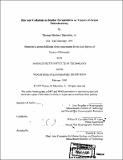Zinc and cadmium in benthic foraminifera as tracers of ocean paleochemistry
Author(s)
Marchitto, Thomas Mathew
DownloadFull printable version (12.68Mb)
Other Contributors
Woods Hole Oceanographic Institution.
Advisor
William B. Curry and Delia W. Oppo.
Terms of use
Metadata
Show full item recordAbstract
Benthic foraminiferal δ13C, Cd/Ca, and Ba/Ca are important tools for reconstructing nutrient distributions, and thus ocean circulation, on glacial-interglacial timescales. However, each tracer has its own "artifacts" that can complicate paleoceanographic interpretations. It is therefore advantageous to measure multiple nutrient proxies with the aim of separating the various complicating effects. Zn/Ca is introduced as an important aid toward this goal. Benthic (Hoeglundina elegans) Cd/Ca ratios from the Bahama Banks indicate that the North Atlantic subtropical gyre was greatly depleted in nutrients during the last glacial maximum (LGM). A high-resolution Cd/Ca record from 965 m water depth suggests that Glacial North Atlantic Intermediate Water formation was strong during the LGM, weakened during the deglaciation, and strengthened again during the Younger Dryas cold period. Comparison of Cd/Ca and δ13C data reveals apparent short-term changes in carbon isotopic air-sea signatures. Benthic foraminiferal Zn/Ca could be a sensitive paleoceanographic tracer because deep water masses have characteristic Zn concentrations that increase about ten-fold from the deep North Atlantic to the deep North Pacific. A "core top calibration" shows that Zn/Ca is controlled by bottom water dissolved Zn concentration and, like Cd/Ca and BalCa, by bottom water saturation state with respect to calcite Since Zn/Ca responds to a different range of saturation states than Cd/Ca, the two may be used together to evaluate changes in deep water carbonate ion (CO32- ) concentration. Zn/Ca and Cd/Ca ratios in the benthic foraminifer Cibicidoides wuellerstorfi exhibit large fluctuations over the past 100,000 years in a deep (3851 m) eastern equatorial Pacific sediment core. The data imply that bottom water CO32- concentrations were lowest during glacial Marine Isotope Stage 4 and highest during the last deglaciation. LGM CO32- concentrations appear to have been within a few μmol kg-1 of modern values. Deep North Atlantic Cd/Ca ratios imply much higher nutrient concentrations during the LGM. Although such data have usually been explained by a northward penetration of Southern Ocean Water (SOW), it has been suggested that they could result from increased preformed nutrient levels in the high-latitude North Atlantic or by increased aging of lower North Atlantic Deep Water (NADW). Glacial Zn/Ca data, however, require a substantially increased mixing with SOW and thus a reduction in NADW formation. Large changes in carbon isotopic air-sea exchange are invoked to reconcile benthic δ13C and trace metal data.
Description
Thesis (Ph. D.)--Joint Program in Oceanography (Massachusetts Institute of Technology, Dept. of Earth, Atmospheric, and Planetary Sciences; and the Woods Hole Oceanographic Institution), February 2000. Includes bibliographical references.
Date issued
2000Department
Joint Program in Oceanography; Woods Hole Oceanographic Institution; Massachusetts Institute of Technology. Department of Ocean EngineeringPublisher
Massachusetts Institute of Technology
Keywords
Joint Program in Oceanography., Earth, Atmospheric, and Planetary Sciences., Woods Hole Oceanographic Institution.